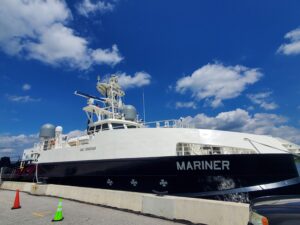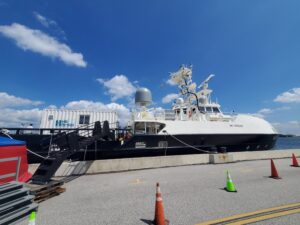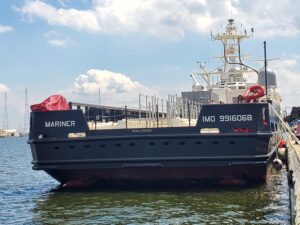ANNAPOLIS, Md. – The Navy christened the newest Ghost Fleet Overlord Unmanned Surface Vessel (OUSV), the Mariner, here at the U.S. Naval Academy on Aug. 23, as it increases unmanned and autonomous vessels used in fleet experimentation.
The Overlord vessels, along with the Medium USVs (MUSVs) Sea Hunter and Seahawk developed by the Defense Advanced Research Projects Agency (DARPA), operate under Surface Development Squadron One (SURFDEVRON One) in San Diego to help develop unmanned vessel concepts of operations.
Mariner is the fourth vessel in the Overlord USV plan, built by prime contractor Leidos [LDOS], which used Gulf Craft based in Franklin, La., to build it. This 194 feet long vessel is based on a commercial design used in the Gulf Coast oil industry as fast supply vessels to service offshore oil rigs. It is currently manned by contracted commercial operators.

Mariner was first delivered to the Navy in March and first sailed from the Gulf Coast to Joint Expeditionary Base Little Creek-Fort Story, Va., to install government-furnished equipment before moving on to Annapolis.
The vessel is currently moored in Annapolis for visits by Navy officials, dignitaries and reporters while the service prepares to sail it to San Diego to join its sister vessels previously built for the DoD Strategic Capabilities Office, Nomad and Ranger. The Navy plans for it to sail to the West Coast in Fiscal Year 2023, which starts in October.
Mariner is one of two OUSVs ordered by the Navy for delivery by the end of this fiscal year. Last year, the Navy noted the third and fourth vessels will include incremental improvements (Defense Daily, July 14, 2021).
The original commercial design the OUSV is based on includes significant autonomy to minimize manning costs for operators, with the Navy adding further unmanned and autonomy systems and redundancy. In a commercial setting, this type of ship can operate with as few as six crew members on two shifts.
Rear Adm. Casey Moton, the program executive officer for unmanned and small combatants, told reporters here Tuesday that these USVs allow the Navy to “test and mature basically our system engineering pillars, which are really applicable to no matter what we build, whether it’s OUSV or MUSVs or something else. A lot of the basics here, the perception and autonomy, the reliable machinery, almost all of that can cross over between those classes. The real differences are the size of the engines.”
“The baseline of what we’re doing, first I want to say is really applicable to whatever approach we go. In terms of requirements, [Large Unmanned Surface Vessel, LUSV] clearly is a program of record requirement with [Vertical Launch System] capability, adjunct magazine capability, is important, it’s in our request. That’s a really big aim of what we’re developing,” he continued.
The third USV, Vanguard, is under construction at Austal USA, under prime contractor L3Harris Technologies [LHX].
Brian Fitzpatrick, the principal assistant program manager for USVs at the Unmanned Maritime Systems program office, PMS 406, told reporters the fourth vessel was delivered before the third because it was already half built when the Navy bought it.
The Vanguard will include some changes, particularly being 205 feet long to the Mariner’s 194 feet, allowing heavier payloads and more fuel.
“The extra length, it’s actually deeper. So it’s deeper, wider, and it’s longer. So lots more volume so we can get more fuel onboard. We can also carry more payloads, not necessarily the size, the length of the payload, but the weight of the payload,” Fitzpatrick said.
“We push boundaries with the design of that vessel,” Moton added.
Moton noted each of the four Overlord USVs have the same base commercial design but have different hull, mechanical and engineering (HM&E) systems as well as different mission systems.
The OUSV includes various commercial systems including satellite communications, three X and S-band radars, an electro-optical sensor mounted on the mast, Link 16, and an electro-optical/infrared camera system viewing six sides of the ship.
A Navy official told reporters each OUSV is using different competing commercial sensors to help determine which are the best fit for the future LUSV, with some unspecified sensors performing better than others.

Notably, the Mariner includes the command and control portions of the Aegis combat system, capable of linking to other Aegis ships in the fleet. It also has datalinks and systems allowing it to act as a mothership for other USVs, so the Navy does not have to dedicate an Arleigh Burke-class (DDG-51) destroyer to the task.
“Frankly, one of the things that’s special about Mariner actually is because we designed Mariner with the ability to control other USVs from Mariner. So now we can take two of our USVs and go out and do multi-vessel ops and control and not necessarily have to take a DDG off of, you know, actual fleet operations to go to that. So it gets us that ability to just get there that much more quickly, I think, through the testing and the different scenarios,” Moton said.
This will help the Navy avoid repeating what happened during USV experimentation at the recent Rim of the Pacific 2022 exercises earlier this month.
While all four prototype Medium USVs participated in the recent Rim of the Pacific (RIMPAC) 2022 exercises this month, Sea Hunter and Seahawk were paired with their own destroyers. During the exercise, one of the destroyers had to unexpectedly drop out of the exercise, so control was moved from the ship to the Navy’s Unmanned Operations Center (UOC) at Naval Base San Diego. The two OUSVs began the exercise controlled out of the UOC (Defense Daily, Aug. 8).
Fitzpatrick said the Navy received about 400 terabytes of data from the four USVs at RIMPAC and it will take a few months to filter the information.
“So we’ve been standing up pipelines, where you can bring that data in to be able to do automated processing of that,” he said.
“We’re also prototyping – so what data do we actually need? What are we going to hold? What don’t we have? So right now it’s collect everything we can. There are a certain amount from a [Convention of the International Regulations Preventing Collisions at Sea, COLREG] side, from an HM&E side we know we want to collect. But right now we’re pulling out everything and then it’s got to set the pipeline up to make that not a two- or three-month evolution, but a couple of days. And that’s the goal. We’re not there yet, we have work we have to do to get there,” Fitzpatrick continued.
Beyond testing autonomous operations, the OUSVs are also configured to hold several payloads for experimentation. Mariner can carry two 20-foot payloads at the front of its payload deck and add either four 40-foot payloads or eight 20-foot payloads or a mixture of the two behind it.

Officials underscored the OUSV has significant redundancy, including five 2,000 horsepower diesel engines that power five water jets as well as bow thrusters, three oil filters compared to the usual one, and a Navy-added third power generator.
The extra generator allows the Mariner to provide up to 72 kilowatts of power for payloads before they need to include their own generators.
During the media tour, the payloads currently aboard this ship include one holding spare parts and another as office space for the crew. Future payloads could include electronic warfare or intelligence, reconnaissance and surveillance assets.
Mariner currently accommodates a small crew including two merchant marine captains. Between the seats for each on the bridge is a large red button that switches autonomous control to manual control within about two seconds.
This feature is shared on the other OUSVs and Navy officials told reporters the button is most often used by newer captains who have less confidence in the autonomy software. They noted testing these vessels is part of building the fleet’s trust in this technology and captains have learned to trust the software over time.